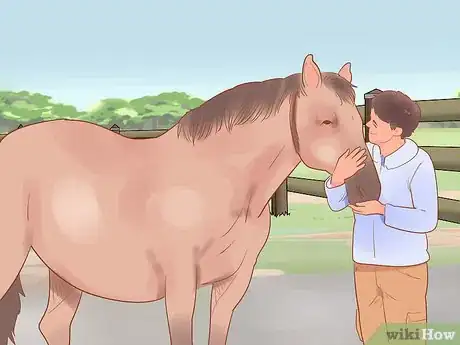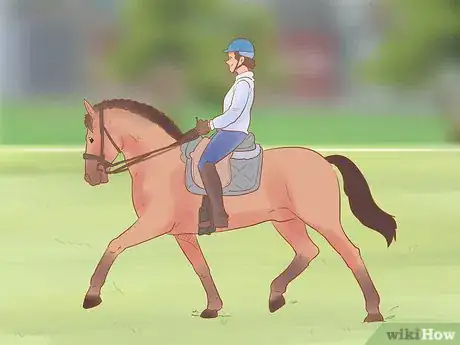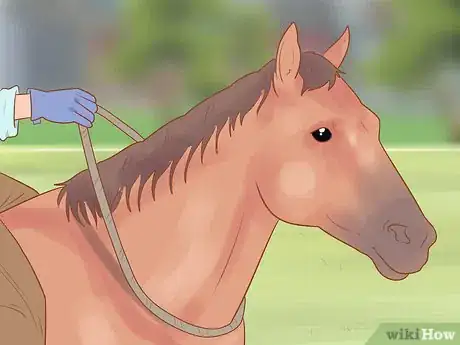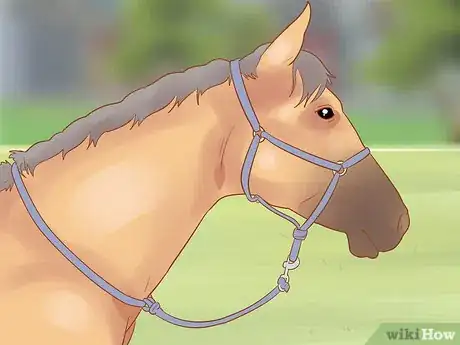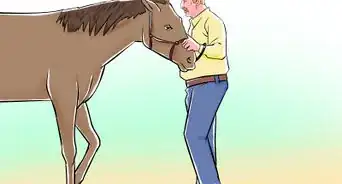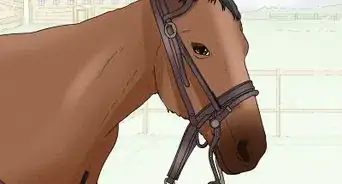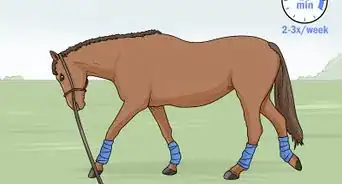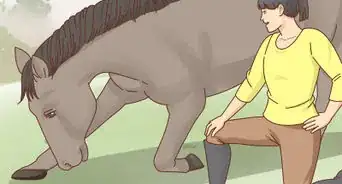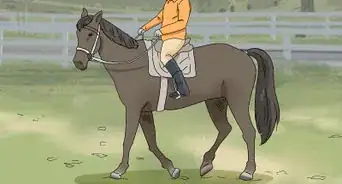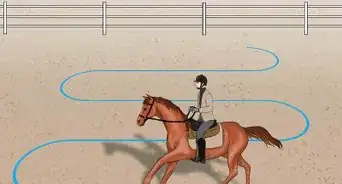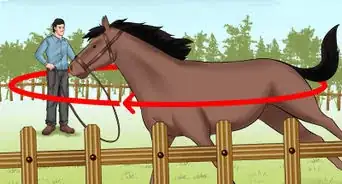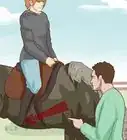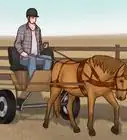This article was co-authored by wikiHow Staff. Our trained team of editors and researchers validate articles for accuracy and comprehensiveness. wikiHow's Content Management Team carefully monitors the work from our editorial staff to ensure that each article is backed by trusted research and meets our high quality standards.
There are 7 references cited in this article, which can be found at the bottom of the page.
This article has been viewed 28,921 times.
Learn more...
If you're bored of riding your horse with a saddle and bridle and want to try something new, tackless horse riding may be the thing for you! However, before you try tackless riding, it's very important that you train your horse first to make sure it's safe to ride without a bridle. Then, all you have to do is get your horse used to responding to just a neck rope and your body pressure while you ride it!
Steps
Training and Preparing Your Horse
-
1Spend time getting to know your horse and honing your riding skills. You'll want to make sure you and your horse are comfortable riding together and that you both have the temperament for it. At the same time, inexperienced riders may fall off of their horse when they first try riding tackless, so it's important that you develop your general riding skills before you try riding with no tack.[1]
- Not all horses have the right build or temperament to ride tackless and their joints and muscles may be injured as a result. Be sure that you're willing to take these chances before you commit to riding tackless.
- Of course, by training yourself and your horse to ride tackless, you will also minimize the chances of either of you getting hurt. So, don't let fear dictate whether you try riding tackless!
- You can get a sense of what it's like to ride tackless by riding in the saddle but with the stirrups dropped. Either drape the stirrups over the saddle horn or just keep your feet out of the irons. Try riding this way at a walk, trot, and canter.
-
2Make sure your horse can walk, trot, and canter at controlled speeds. Your horse will need to be under enough control that, whether you're walking, trotting, or cantering, you can ride it at a distance without your horse speeding up or having to be reined in. If your horse has trouble doing this, ride it around an enclosed space for a few minutes at a steady trot to help it find its rhythm.[2]
- You may need to train your horse in basic controls and riding speed before you attempt to ride it tackless.
Advertisement -
3Get your horse used to stopping on command. Lean back, putting your legs forward and saying "woah," and squeeze the reins if needed to tell the horse to stop. Then, praise it as soon as it does. Repeat this process until your horse is able to stop in response to you shifting your body weight and applying slight pressure.[3]
- Your goal should be to be able to get the horse to stop without actually having to pull on the reins.
- The easiest way to praise the horse for stopping is to release all physical pressure and then verbally praise it while scratching along its neck and withers.
-
4Be sure you can calm and control your horse when it gets spooked. Being able to get your horse to stop when you say “stop” is one thing; being able to get your horse under control when it gets spooked is much different. If your horse gets easily spooked or rears a lot, continue riding it and training it with a saddle and bridle until it's unlikely to get spooked with you riding on it.[4]
- This is very important, since if the horse gets spooked and rears while you're riding it without a saddle and bridle, you're much more likely to fall off of it and sustain an injury.
-
5Teach your horse to neck rein so that it responds to light pressure. The idea is to teach the horse that when you set the neck rope against the left side of its neck, it will turn its head away from the pressure (to the right), and vice versa. Lean inwards into each turn so that the horse also associates the command to turn with the shift in your body weight.[5]
- If your horse has no experience with a neck rope, start by using both a bridle and a neck rope at the same time. When you turn your horse using the bridle, push the neck rope against its neck as well. Repeat this process until the horse associates the pressure of the neck rope with turning.
Acclimating Your Horse to Riding Tackless
-
1Practice tackless riding in an arena until you get used to it. Until you and your horse are both comfortable with tackless riding, stick to practicing in an arena only. That way, in case you fall off or lose control of your horse, it won't be able to run off anywhere.
- Do a search online for a riding arena near you or ask your vet or a friend who rides for a recommendation.
-
2Start by riding your horse using a neck rope with the reins tied up. Leave the bridle on the horse, in case you need it to regain control in a pinch. Otherwise, use the neck rope to get your horse to turn and brake on command.[6]
- Leave the saddle on the horse, as well. At this point, your only goal should be to carefully test out whether the horse will respond to the neck rope alone.
-
3Ride without the bridle and using only a neck rope. Hold the rope like a pair of reins or in 1 hand, whichever you prefer. Start out with just a walk, then slowly progress to trotting around in circles, making sure that both you and the horse are comfortable riding completely without the bridle.[7]
- If you feel up to it, try cantering without the bridle as well.
-
4Practice riding slowly without the saddle as well. You'll want to make sure that you're able to maintain good balance without the saddle and that the horse's balance isn't thrown off kilter. Keep things slow for a couple rides so you and your horse can get a feel for it before trying out a trot.[8]
- If your horse's back is rather slick, feel free to use a bareback pad during the first few rides. This'll offer you a bit more grip.
- Keeping the bridle on the horse is also a good way to maintain your balance while you're first learning to ride bareback. Just make sure you eventually progress to not having the bridle on anymore.
-
5Add faster speeds and longer distances to your tackless riding. Once you're sure you're able to control your horse and stay on it without either the bridle or the saddle, start trying out trots and canters with your tackless riding. Practice riding your horse without a tack every day to make sure that your newfound skills stay sharp.[9]
- Don't rush it! If your horse does great at walking without a tack, but is harder to control at a trot, don't try trotting without a tack too soon. Work your way up to it over the course of a few days.
- If you have trouble keeping your horse under control at a trot, you can train it by giving it praise and a snack whenever it quickly responds to signals from your body.
Community Q&A
-
QuestionWhat if my horse doesn't trust anyone because no one gave her a chance, and she is mourning her horse friend's death?
 Community AnswerComfort the horse and earn its trust. Show you won't hurt it. Try feeding it and grooming it and giving it attention. Be patient, these things take time.
Community AnswerComfort the horse and earn its trust. Show you won't hurt it. Try feeding it and grooming it and giving it attention. Be patient, these things take time. -
QuestionCan I teach a 25-year-old horse to ride tackless?
 Community AnswerYes, you can. First, if the horse is not used to being ridden without a saddle, it would be wise to start riding without a saddle so it becomes more familiar and less strange to the horse. Then I would slowly work with making sure you or whoever the rider is uses enough leg pressure to be able to direct the horse by legs and not using the reins. Once the horse is fine riding bareback, start using leg pressure to direct the horse and practice with the bridle on but try not to use the reins, then work your way up to not using the reins at all, and then not even needing to put on a bridle.
Community AnswerYes, you can. First, if the horse is not used to being ridden without a saddle, it would be wise to start riding without a saddle so it becomes more familiar and less strange to the horse. Then I would slowly work with making sure you or whoever the rider is uses enough leg pressure to be able to direct the horse by legs and not using the reins. Once the horse is fine riding bareback, start using leg pressure to direct the horse and practice with the bridle on but try not to use the reins, then work your way up to not using the reins at all, and then not even needing to put on a bridle. -
QuestionI have a mare and I trust her a lot, but she isn't used to a neck rope. I have followed the steps above, but she doesn't like being asked to stop with the lead rope on her neck. What should I do?
 Community AnswerMake sure she can stop with just your seat cues or a voice cue. Teach her that, "whoa," means stop with a bridle on, then try with the bridle still on, but don't touch the reins. Once that makes her stop immediately, then try the neck rope.
Community AnswerMake sure she can stop with just your seat cues or a voice cue. Teach her that, "whoa," means stop with a bridle on, then try with the bridle still on, but don't touch the reins. Once that makes her stop immediately, then try the neck rope.
Warnings
- Although you probably have a good relationship with your horse, it's still an often unpredictable animal. Make sure you always wear a hard hat and exercise caution when riding a horse.⧼thumbs_response⧽
Things You'll Need
- Neck rope
References
- ↑ https://www.horselistening.com/2013/04/08/3-questions-to-consider-before-riding-bareback-and-bridleless/
- ↑ https://www.youtube.com/watch?v=K2FzKXTJYYM#t=34s
- ↑ https://www.horselistening.com/2013/04/08/3-questions-to-consider-before-riding-bareback-and-bridleless/
- ↑ https://www.horselistening.com/2013/04/08/3-questions-to-consider-before-riding-bareback-and-bridleless/
- ↑ https://www.youtube.com/watch?v=gYqVeknFDro#t=15s
- ↑ https://www.youtube.com/watch?v=gYqVeknFDro#t=01m05s
- ↑ https://www.youtube.com/watch?v=uqBX4TdlK8E#t=02m04s
- ↑ https://www.youtube.com/watch?v=uqBX4TdlK8E#t=02m29s
- ↑ https://www.youtube.com/watch?v=K2FzKXTJYYM#t=06m46s
About This Article
To teach a horse to ride tackless, spend time riding and getting to know your horse first. Make sure it can walk, trot, and canter at controlled speeds and stop on command before trying tackless riding. Next, practice riding your horse using only the neck rope without the bridle. Then, devote a few sessions to riding slowly without a saddle. Gradually increase your speed to trots and canters as your horse gets more comfortable. For more tips on tackless training, read on!
